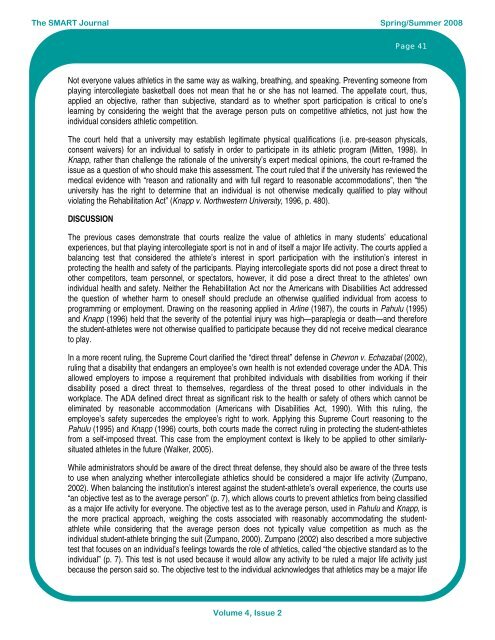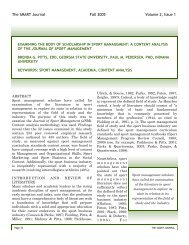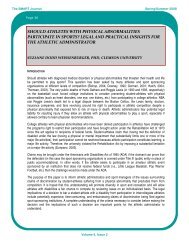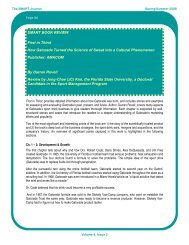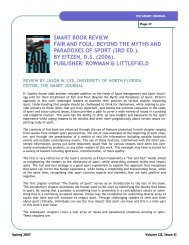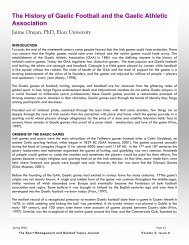Spring/Summer 2008 Volume 4, Issue 2 - The SMART Journal
Spring/Summer 2008 Volume 4, Issue 2 - The SMART Journal
Spring/Summer 2008 Volume 4, Issue 2 - The SMART Journal
Create successful ePaper yourself
Turn your PDF publications into a flip-book with our unique Google optimized e-Paper software.
<strong>The</strong> <strong>SMART</strong> <strong>Journal</strong> <strong>Spring</strong>/<strong>Summer</strong> <strong>2008</strong><br />
Page 41<br />
Not everyone values athletics in the same way as walking, breathing, and speaking. Preventing someone from<br />
playing intercollegiate basketball does not mean that he or she has not learned. <strong>The</strong> appellate court, thus,<br />
applied an objective, rather than subjective, standard as to whether sport participation is critical to one’s<br />
learning by considering the weight that the average person puts on competitive athletics, not just how the<br />
individual considers athletic competition.<br />
<strong>The</strong> court held that a university may establish legitimate physical qualifications (i.e. pre-season physicals,<br />
consent waivers) for an individual to satisfy in order to participate in its athletic program (Mitten, 1998). In<br />
Knapp, rather than challenge the rationale of the university’s expert medical opinions, the court re-framed the<br />
issue as a question of who should make this assessment. <strong>The</strong> court ruled that if the university has reviewed the<br />
medical evidence with “reason and rationality and with full regard to reasonable accommodations”, then “the<br />
university has the right to determine that an individual is not otherwise medically qualified to play without<br />
violating the Rehabilitation Act” (Knapp v. Northwestern University, 1996, p. 480).<br />
DISCUSSION<br />
<strong>The</strong> previous cases demonstrate that courts realize the value of athletics in many students’ educational<br />
experiences, but that playing intercollegiate sport is not in and of itself a major life activity. <strong>The</strong> courts applied a<br />
balancing test that considered the athlete’s interest in sport participation with the institution’s interest in<br />
protecting the health and safety of the participants. Playing intercollegiate sports did not pose a direct threat to<br />
other competitors, team personnel, or spectators, however, it did pose a direct threat to the athletes’ own<br />
individual health and safety. Neither the Rehabilitation Act nor the Americans with Disabilities Act addressed<br />
the question of whether harm to oneself should preclude an otherwise qualified individual from access to<br />
programming or employment. Drawing on the reasoning applied in Arline (1987), the courts in Pahulu (1995)<br />
and Knapp (1996) held that the severity of the potential injury was high—paraplegia or death—and therefore<br />
the student-athletes were not otherwise qualified to participate because they did not receive medical clearance<br />
to play.<br />
In a more recent ruling, the Supreme Court clarified the “direct threat” defense in Chevron v. Echazabal (2002),<br />
ruling that a disability that endangers an employee’s own health is not extended coverage under the ADA. This<br />
allowed employers to impose a requirement that prohibited individuals with disabilities from working if their<br />
disability posed a direct threat to themselves, regardless of the threat posed to other individuals in the<br />
workplace. <strong>The</strong> ADA defined direct threat as significant risk to the health or safety of others which cannot be<br />
eliminated by reasonable accommodation (Americans with Disabilities Act, 1990). With this ruling, the<br />
employee’s safety supercedes the employee’s right to work. Applying this Supreme Court reasoning to the<br />
Pahulu (1995) and Knapp (1996) courts, both courts made the correct ruling in protecting the student-athletes<br />
from a self-imposed threat. This case from the employment context is likely to be applied to other similarlysituated<br />
athletes in the future (Walker, 2005).<br />
While administrators should be aware of the direct threat defense, they should also be aware of the three tests<br />
to use when analyzing whether intercollegiate athletics should be considered a major life activity (Zumpano,<br />
2002). When balancing the institution’s interest against the student-athlete’s overall experience, the courts use<br />
“an objective test as to the average person” (p. 7), which allows courts to prevent athletics from being classified<br />
as a major life activity for everyone. <strong>The</strong> objective test as to the average person, used in Pahulu and Knapp, is<br />
the more practical approach, weighing the costs associated with reasonably accommodating the studentathlete<br />
while considering that the average person does not typically value competition as much as the<br />
individual student-athlete bringing the suit (Zumpano, 2000). Zumpano (2002) also described a more subjective<br />
test that focuses on an individual’s feelings towards the role of athletics, called “the objective standard as to the<br />
individual” (p. 7). This test is not used because it would allow any activity to be ruled a major life activity just<br />
because the person said so. <strong>The</strong> objective test to the individual acknowledges that athletics may be a major life<br />
<strong>Volume</strong> 4, <strong>Issue</strong> 2


